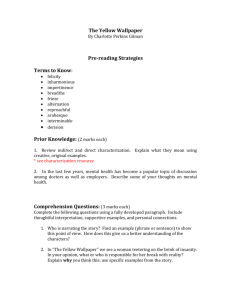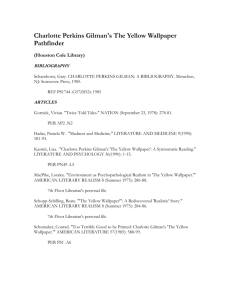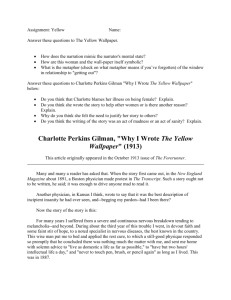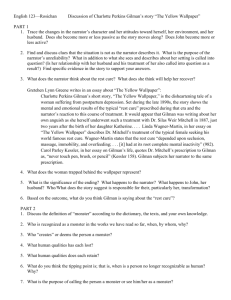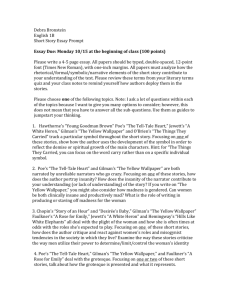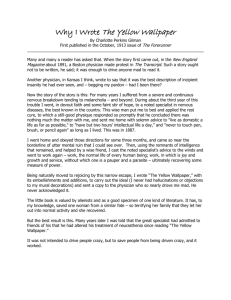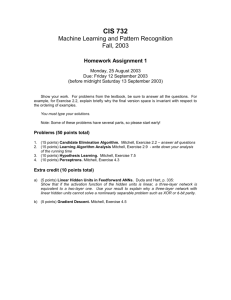Why I Wrote "The Yellow Wallpaper"
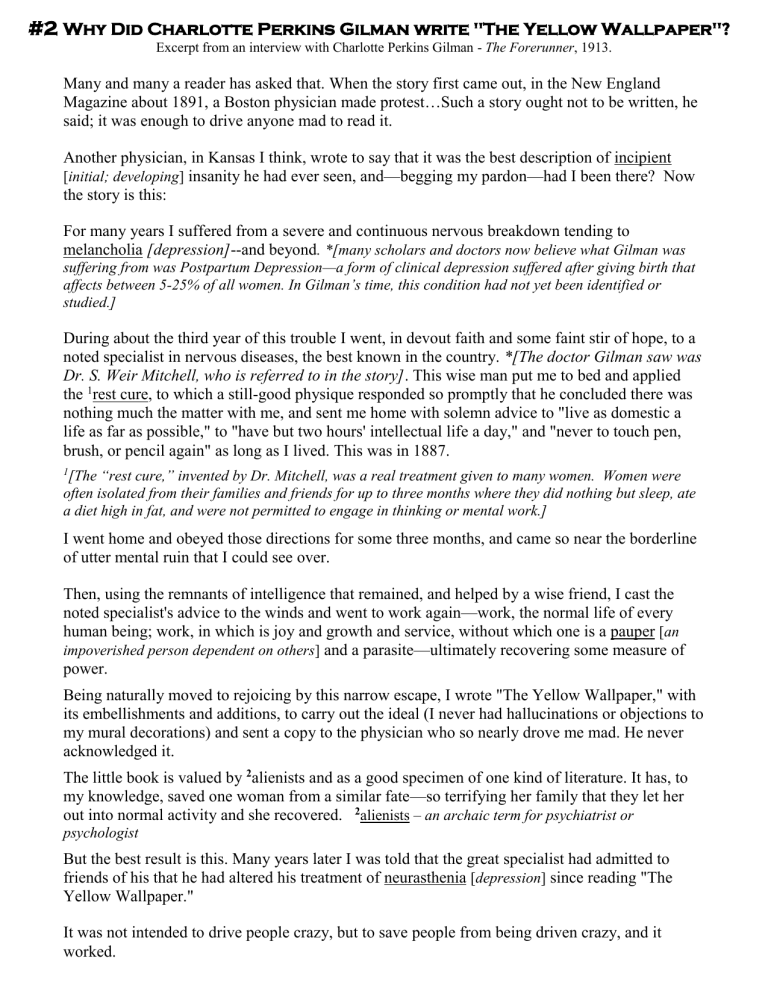
#2 Why Did Charlotte Perkins Gilman write "The Yellow Wallpaper"?
Excerpt from an interview with Charlotte Perkins Gilman - The Forerunner , 1913.
Many and many a reader has asked that. When the story first came out, in the New England
Magazine about 1891, a Boston physician made protest…Such a story ought not to be written, he said; it was enough to drive anyone mad to read it.
Another physician, in Kansas I think, wrote to say that it was the best description of incipient
[ initial; developing ] insanity he had ever seen, and—begging my pardon—had I been there? Now the story is this:
For many years I suffered from a severe and continuous nervous breakdown tending to melancholia [depression] --and beyond . *[many scholars and doctors now believe what Gilman was suffering from was Postpartum Depression—a form of clinical depression suffered after giving birth that affects between 5-25% of all women. In Gilman’s time, this condition had not yet been identified or studied.]
During about the third year of this trouble I went, in devout faith and some faint stir of hope, to a noted specialist in nervous diseases, the best known in the country. *[The doctor Gilman saw was
Dr. S. Weir Mitchell, who is referred to in the story] . This wise man put me to bed and applied the
1 rest cure, to which a still-good physique responded so promptly that he concluded there was nothing much the matter with me, and sent me home with solemn advice to "live as domestic a life as far as possible," to "have but two hours' intellectual life a day," and "never to touch pen, brush, or pencil again" as long as I lived. This was in 1887.
1 [The “rest cure,” invented by Dr. Mitchell, was a real treatment given to many women. Women were often isolated from their families and friends for up to three months where they did nothing but sleep, ate a diet high in fat, and were not permitted to engage in thinking or mental work.]
I went home and obeyed those directions for some three months, and came so near the borderline of utter mental ruin that I could see over.
Then, using the remnants of intelligence that remained, and helped by a wise friend, I cast the noted specialist's advice to the winds and went to work again—work, the normal life of every human being; work, in which is joy and growth and service, without which one is a pauper [ an impoverished person dependent on others ] and a parasite—ultimately recovering some measure of power.
Being naturally moved to rejoicing by this narrow escape, I wrote "The Yellow Wallpaper," with its embellishments and additions, to carry out the ideal (I never had hallucinations or objections to my mural decorations) and sent a copy to the physician who so nearly drove me mad. He never acknowledged it.
The little book is valued by 2 alienists and as a good specimen of one kind of literature. It has, to my knowledge, saved one woman from a similar fate—so terrifying her family that they let her out into normal activity and she recovered. 2 alienists – an archaic term for psychiatrist or psychologist
But the best result is this. Many years later I was told that the great specialist had admitted to friends of his that he had altered his treatment of neurasthenia [ depression ] since reading "The
Yellow Wallpaper."
It was not intended to drive people crazy, but to save people from being driven crazy, and it worked.
FIRST read Charlotte Perkins Gilman’s explanation “Why I Wrote the
Yellow Wallpaper.”
1. A personal experience with what kind of illness inspired Gilman to write “The Yellow
Wallpaper”?
2. Gilman, when describing her own experience of following her doctor’s advice, recalls,
“I went home and obeyed those directions for some three months, and … came so near the borderline of utter mental ruin…”
A) What specific directions had Gilman followed?
B) Why do you think following the doctor’s advice affected her mental state so severely?
C) What parts of your life or “work” (your passion) would send you to “utter mental ruin” if you were asked to give them up?
"Every kind of creature is developed by the exercise of its functions. If denied the exercise of its functions, it can not develop in the fullest degree."
~quote from Charlotte Perkins Gilman’s testimony before the House of Representatives Judiciary
Committee on behalf of the National American Woman Suffrage Association. January 28, 1896
Decode/paraphrase this quote into everyday language (What’s her point?):
How does the statement apply to “The Yellow Wallpaper”?
#4
Reading:
Dr. Weir Mitchell and 19 th Century
Myths about Women’s Bodies
Many in the medical community used faulty science to justify keeping women from working, experiencing a college education, or attending a mixed-gender high school.
Arguments about women’s inferior intelligence were based on the following fallacies and misperceptions:
A) Since women were generally physically smaller than men that must mean they are weak and less evolved.
B) The belief that women had less physical stamina than men because they seemed to faint so much more ( a problem often related to the restrictive clothing worn by women and the fact that they were not encouraged to exercise ).
C) Since women menstruated, they were assumed to be physically incapacitated every month. Menstruation was regarded as a periodic illness inflicted upon women. It was even believed that it could bring on temporary insanity in women. Clearly, women were inferior to men, who were not interrupted or incapacitated every month by illness.
In fact, Dr. Silas Weir Mitchell—the physician alluded to in “The
Yellow Wallpaper”—whom Charlotte Perkins Gilman saw in real life—claimed to have discovered a seventeen-year old girl who
"lost" her menstrual cycle while attending a "school in which boys and girls were educated together" (Mitchell). Once she was sent home, however, her menstrual flow miraculously returned in a few weeks and the young woman's health was
Dr. Weir Mitchell gradually restored.
D) During Gilman’s time, it was even suggested by some scientists that education took away about 20% of a woman's vital energy!
In addressing a college’s student body in 1890, Dr. Weir Mitchell expressed his concern that women might collapse under the strain that higher education imposed on their physical and emotional state and insisted, "I no more want
[women] to be preachers, lawyers, or platform orators, than I want men to be seamstresses or nurses of children." His notion of a proper education for women was one limited to childcare and domestic skills. Mitchell objected to any girl under the age of seventeen using her brain even moderately. To do so, he warned, would endanger her health and risk a future limited to "the shawl and the sofa" (Mitchell).
#4 –
Group Recorder Sheet
Dr. Weir Mitchell and 19
th
Century Myths about Women’s Bodies
First, read the handout!
1. How do John’s actions and statements in “The Yellow Wallpaper” reflect some of the 19 th Century beliefs you read, held by Dr. Weir Mitchell and others, about women, their bodies, and education? (Complete the template below.)
In “The Yellow Wallpaper,” when______________________________________________
__________________________________________________________________________
(detail from the story) this reflects the 19 th Century belief that __________________________________________
___________________________________________________________________________
(paraphrased or quoted detail from the handout)
2. What details in “The Yellow Wallpaper” suggest the narrator has had some kind of an education? (Look especially at the narrator’s vocabulary in the first half of p.805 in the text. In what areas of study does she seem to possess knowledge?)
3. List TWO current myths, misperceptions, or stereotypes about women’s or men’s bodies or minds.
A)
B)
